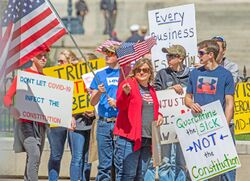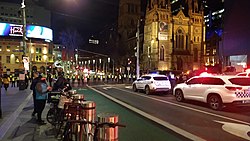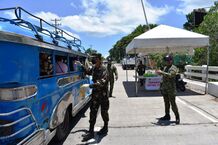Social:COVID-19 lockdowns
Due to the COVID-19 pandemic, a number of non-pharmaceutical interventions colloquially known as lockdowns (encompassing stay-at-home orders, curfews, quarantines, cordons sanitaires and similar societal restrictions) have been implemented in numerous countries and territories around the world.[1] These restrictions were established with the intention to reduce the spread of SARS-CoV-2, the virus that causes COVID-19.[2] By April 2020, about half of the world's population was under some form of lockdown, with more than 3.9 billion people in more than 90 countries or territories having been asked or ordered to stay at home by their governments.[3] Although similar disease control measures have been used for hundreds of years, the scale of those implemented in the 2020s is thought to be unprecedented.[4][failed verification]
Research and case studies have shown that lockdowns were generally effective at reducing the spread of COVID-19, therefore flattening the curve.[5][6][7] The World Health Organization's recommendation on lockdowns is that they should be very brief, short-term measures to reorganize, regroup, rebalance resources, and protect health workers who are exhausted.[citation needed] To achieve a balance between restrictions and normal life, the WHO recommends a response to the pandemic that consists of strict personal hygiene, effective contact tracing, and isolating when ill.[8][better source needed]
In addition to the health effects of lockdown restrictions,[9] researchers have found the lockdowns have reduced crime and violence by armed non-state actors, such as the Islamic State, and other terrorist groups.[10] They have also had profound negative economic impacts, and have been met with protests in some territories.
Efficacy
Several researchers, from modeling and demonstrated examples, have concluded that lockdowns were somewhat effective at reducing the spread of, and deaths caused by, COVID-19.[5][6][11][7][12][13][14][15][16] Lockdowns are thought to be most effective at containing or preventing COVID-19 community transmission, healthcare costs and deaths when implemented earlier, with greater stringency, and when not lifted too early.[17][18][19][20][21]
A study investigating the spread based on studies of the most common symptoms such as loss of taste and smell in France, Italy and the UK showed a marked decrease in new symptoms just a few days after the start of confinement on the countries (Italy and France) with the strongest lockdowns.[22] Modelling on the United States pandemic suggested "the pandemic would have been almost completely suppressed from significantly taking off if the lockdown measures were implemented two weeks earlier" and that the second wave would have been less severe had the lockdown lasted another two weeks.[17]
The stringent lockdown in Hubei in early 2020 proved effective at controlling the COVID-19 outbreak in China.[15][23] The relatively high number of cases and deaths in Sweden, which has kept much of its society open during the pandemic, when compared to its neighbours with comparable demographics Norway, Denmark and Finland that did enforce lockdowns, is thought to be at least partly attributable to this difference in policy.[24][25][26][27][28][29][30] Similarly, modelling on Australian data concluded that achieving zero community transmission through a strict lockdown lowers healthcare and economic costs compared to less stringent measures that allow transmission to continue, and warned that early relaxation of restrictions have greater costs.[19][20] This "zero community transmission" approach was adopted in Australia, and a strict four month lockdown in the state of Victoria during an outbreak in Melbourne, combined with other measures, averted a wider outbreak in the country in 2020.[31] New Zealand and Vietnam also adopted a "Zero-COVID" strategy throughout 2020 that included targeted lockdowns.[32][33]
The emergence of the highly transmissible SARS-CoV-2 Delta variant in 2021 has led some commentators to suggest that although lockdowns continue to reduce the spread of COVID-19, they have become less effective at containing it. Lockdowns in Australia and Vietnam in response to Delta outbreaks proved less effective at containment than previous lockdowns were against the spread of other variants.[34][35][36]
Voluntary versus mandatory restrictions

One study led by an economist at the University of Chicago found that involuntary lockdowns had little impact, with voluntary distancing making up nearly 90% of the fall in consumer traffic as people feared the virus itself.[37] Similarly, a National Bureau of Economic Research study found stay-at-home orders increased staying at home by just 5–10%.[38] Another study from Yale University found that most social distancing was voluntary, driven primarily by "media coverage of morbidity and mortality".[39]
On the other hand, some studies have argued[14][40] that coercive measures probably decreased interactions, while accepting that most of the reduction may have been voluntary. One of those two studies, by Flaxman et al., has been criticized, among other things for having a country-specific adjustment factor, without which the model would predict a massive number of deaths for Sweden.[41] One widely cited economic simulation asserting that shelter-in-place orders reduced total cases three-fold, however, held voluntary distancing constant.[42] Another study found a 30% difference among border-counties where stay-at-home orders were imposed.[43]
Another study that compared the impact of 'less restrictive interventions' on the spread of COVID-19 in Sweden and South Korea, with mandatory stay-at home orders in 8 other countries, such as France and Spain, did not find evidence for greater disease control in the countries with more restrictions.[44] However, the findings of the study have been questioned due to its numerous limitations, including the small sample size of countries.[45][46]
Some research has also found that an "advisory" approach is not adequate to control COVID-19 outbreaks. An analysis of an outbreak in northern Italy found that an effective reduction in community transmission occurred during a strict national lockdown, and that earlier less stringent measures were ineffective at reducing mobility to a level low enough to reduce the spread of COVID-19.[18]
Since the beginning of the pandemic, Google has consistently collected data on movements, showing rapid declines in public activity long before legal restrictions were imposed.[47] An April 2020 poll found that 93% of Americans voluntarily chose to only leave home when necessary, regardless of legal restrictions.[48]
Reception
A February 2021 review of 348 articles concluded there was acknowledgement of the importance of non-pharmaceutical interventions in controlling the spread of COVID-19.[7] However, later research also acknowledges high societal costs, though in some circumstances less than the costs of allowing the pandemic to spread without mitigation.[6][5][7]
Related to epidemiology
Epidemiological evidence supports generalized non-pharmaceutical interventions to curb the spread of COVID-19.[7][49][50][51]
During the early stages of the pandemic in Europe and the United States, statistical modeling which advised that restrictions were helpful to prevent a large number of deaths were used as the basis for lockdowns.[16] This includes an Imperial College projection, led by epidemiologist Neil Ferguson.[52] Despite some criticisms, academics defended the Imperial projection as fundamentally sound, while admitting the code was "a buggy mess".[53] Retrospective evaluation of lockdowns and computer modeling has verified that they have significantly contributed to reducing mortality and morbidity from COVID-19.[54]
A notable opponent of lockdowns has included Sweden's state epidemiologist Anders Tegnell, who has frequently criticised the strategy.[55][56] The Swedish government's approach has included minimal restrictions and has been controversial in part due to the relatively high death toll due to widespread transmission.[57][58] However, the Swedish government began considering enacting a lockdown in early 2021.[59][60]
While arguing in August 2020 for the need for further lockdowns in the United States, physicians Ranu Dhillon and Abraar Karan argued for "smarter lockdowns" that impose restrictions on areas with high levels of transmission, and to increase support to vulnerable populations in these locations to offset the economic costs.[61]
A number of medical experts signed the Great Barrington Declaration in October 2020 which called for "Focused Protection" on high risk groups and minimal restrictions on the general population to achieve herd immunity through COVID-19 infection. However, the majority of medical experts and the WHO have strongly criticised this proposed strategy for its lack of scientific basis and for being unethical.[50][62][63] The declaration has also attracted controversy over its funding and the authenticity of its signatures.[49][64]
Related to social impacts
Some commentators have suggested that states' use of emergency powers to curb freedom of assembly and movement are authoritarian and may result in long-term democratic backsliding.[65] Centralization of power by political leadership in Hungary, Poland, China and Cambodia in response to the COVID-19 pandemic have been cited as examples.[66][67][68]
Some researchers have noted that COVID-19 pandemic restrictions have come with mental health costs, compounded by those caused by the COVID-19 pandemic itself.[7][69][70][71][72]
Due to their closure, educational institutions worldwide transitioned to online learning. Teachers and faculty had to learn new ways to engage with students while in a COVID-19 pandemic. Examples of online teaching tools are podcasts, videos, and virtual classrooms.[73][better source needed]
UN Women warned in an April 2020 report that COVID-19 pandemic restrictions exacerbate gender inequalities and have led to an increase in domestic violence.[74] Many women were being forced to 'lockdown' at home with their abusers at the same time that services to support survivors are being disrupted or made inaccessible.[75] For instance, in France there was around a 30% spike in cases of since the lockdown in March 2020.[74]
Telehealth had an important role to allow physicians not to miss the follow-up of patients with different chronic diseases and potentially helped to contain SARS-CoV-2 spreading among both patients and healthcare providers [76] During the COVID-19 pandemic, video-communications became an easy-to-use quick-to-learn tool for many people, and the anxiety to contract COVID-19 could have counterbalanced some patients’ low level of trust in technology. For these reasons, most patients accepted to receive a video-consultation in spite of the traditional in-person visit and trusted telemedicine. [77]
Related to economic impacts
Some economists supported increased government funding for mitigation efforts, even at the cost of tolerating a very large economic contraction.[78] They agreed that lockdowns should continue until the threat of resurgence has declined, even when considering only the economic impact.[79] There was a general agreement, at least in some economic circles, that "severe lockdowns — including closing non-essential businesses and strict limitations on people's movement — are likely to be better for the economy in the medium term than less aggressive measures".[80]

Both the World Food Programme (WFP) and the World Health Organization (WHO) have published statements noting the impact of the lockdowns on livelihoods and food security, and David Nabarro, WHO Special Envoy on COVID-19 stated in October 2020 that "lockdowns just have one consequence that you must never ever belittle, and that is making poor people an awful lot poorer".[81][82][83]
Protests

There have also been a number of protests worldwide in opposition to lockdowns, including in the United Kingdom, the United States, Australia, Germany, the Netherlands, Canada and New Zealand. The motivations for and sizes of these protests have varied. Some have been spurred by the economic and social impacts of lockdowns, but have also been associated with misinformation related to the pandemic, conspiracy theories and anti-vaccination.[84][85]
Table of pandemic lockdowns
In the table pandemic lockdowns are defined as the shutdown of parts of the economy,[86] due to non-pharmaceutical anti-pandemic measures and are enforceable by law like:
- Closing of schools and kindergartens
- Closing of non-essential shops (shops and stores apart from food, doctors and drug stores)
- Closing of non-essential production
- Cancellation of recreational venues and closing of public places
- Curfews
- Stay-at-home orders and total movement control
These measures are considered to have caused the COVID-19 recession in 2020.[87] The table does not contain:
- Measures with smaller economic impacts like:
- border closures
- social distancing measures and social movement restrictions
- travel restrictions.
- Other non-pharmaceutical anti-pandemic measures like mandatory quarantines after travel, self quarantine and social distancing measures
- Any measures which are voluntary rather than enforceable by law
The pandemic has resulted in the largest number of shutdowns/lockdowns worldwide at the same time in history.[88] By 26 March, 1.7 billion people worldwide were under some form of lockdown,[89] which increased to 3.9 billion people by the first week of April – more than half of the world's population.[90][91] Lockdowns affect 93% of workers worldwide. 30% live in nations with complete workplace closures, save for critical businesses, and 42% in countries with partial closures. Nearly 20% live in nations with recommended but not compulsory workplace shutdown.[92]
Major restrictions first began in China,[93] with other countries in East Asia like Vietnam soon following it in implementing widespread containment measures. Much of Europe, North America and Africa took much longer to bring in tough measures. Lockdowns between and within nations are of varying stringency.[94]
By mid April, nearly 300 million people, or about 90 per cent of the population, were under some form of lockdown in the United States,[95] with around 100 million in the Philippines[96] and about 59 million in South Africa,[97] while around 1.3 billion were under lockdown in India, which was the largest of all lockdowns.[98][99]
By the end of April, around 300 million people were under lockdown in various countries of Europe, including but not limited to Italy, Spain, France, and the United Kingdom; while around 200 million people were under lockdown in Latin America.[96] In Germany, 35% of workers did work from home in addition to their regular on-site duties, while 26% did so exclusively.[100]
Variation by countries and territories

See also
- Cordon sanitaire
- COVID-19 community quarantines in the Philippines
- COVID-19 lockdown in China
- COVID-19 lockdown in India
- COVID-19 lockdowns in Italy
- Flattening the curve
- List of species named after the COVID-19 pandemic (including lockdowns)
- Malaysian movement control order
- National responses to the COVID-19 pandemic
- Preventive action
- Stay-at-home order
- Timeline of the COVID-19 pandemic
- Support bubble
References
- ↑ Li, Lili; Taeihagh, Araz; Tan, Si Ying (2023-02-03). "A scoping review of the impacts of COVID-19 physical distancing measures on vulnerable population groups" (in en). Nature Communications 14 (1): 599. doi:10.1038/s41467-023-36267-9. ISSN 2041-1723. PMID 36737447. Bibcode: 2023NatCo..14..599L.
- ↑ "Coronavirus: 7 dead, 229 infected in Italy as Europe braces for COVID-19". NBC News. 25 February 2020. https://www.nbcnews.com/news/world/coronavirus-updates-5-dead-200-infected-italy-europe-braces-covid-n1141466.
- ↑ Sandford, Alasdair (2 April 2020). "Coronavirus: Half of humanity on lockdown in 90 countries" (in en). https://www.euronews.com/2020/04/02/coronavirus-in-europe-spain-s-death-toll-hits-10-000-after-record-950-new-deaths-in-24-hou.
- ↑ Script error: No such module "cite news".
- ↑ 5.0 5.1 5.2 Bendavid, E; Oh, C; Bhattacharya, J; Ioannidis, JPA (April 2021). "Assessing mandatory stay-at-home and business closure effects on the spread of COVID-19.". European Journal of Clinical Investigation 51 (4): e13484. doi:10.1111/eci.13484. PMID 33400268.
- ↑ 6.0 6.1 6.2 Bjørnskov, Christian (29 March 2021). "Did Lockdown Work? An Economist's Cross-Country Comparison". CESifo Economic Studies 67 (3): 318–331. doi:10.1093/cesifo/ifab003.
- ↑ 7.0 7.1 7.2 7.3 7.4 7.5 Perra, Nicola (13 February 2021). "Non-pharmaceutical interventions during the COVID-19 pandemic: A review". Physics Reports 913: 1–52. doi:10.1016/j.physrep.2021.02.001. ISSN 0370-1573. PMID 33612922. Bibcode: 2021PhR...913....1P.
- ↑ Doyle, Michael (11 October 2020). "WHO doctor says lockdowns should not be main coronavirus defence". https://www.abc.net.au/news/2020-10-12/world-health-organization-coronavirus-lockdown-advice/12753688.
- ↑ Greenhut, Steven (25 March 2022). "COVID Revealed America To Be a Nation of Rulers, Not of Laws". Reason. https://reason.com/2022/03/25/covid-revealed-america-to-be-a-nation-of-rulers-not-of-laws/.
- ↑ Brancati, Dawn (2023). "Locking Down Violence: The COVID-19 Pandemic's Impact on Non-State Actor Violence" (in en). American Political Science Review January (1): 1327–1343. doi:10.1017/S0003055422001423.
- ↑ Sharma, Mrinank; Mindermann, Sören; Rogers-Smith, Charlie; Leech, Gavin; Snodin, Benedict; Ahuja, Janvi; Sandbrink, Jonas B.; Teperowski Monrad, Joshua et al. (5 October 2021). "Understanding the effectiveness of government interventions against the resurgence of COVID-19 in Europe" (in en). Nature Communications 12 (1): 5820. doi:10.1038/s41467-021-26013-4. ISSN 2041-1723. PMID 34611158. Bibcode: 2021NatCo..12.5820S.
- ↑ Brauner, Jan M.; Mindermann, Sören; Sharma, Mrinank; Johnston, David; Salvatier, John; Gavenčiak, Tomáš; Stephenson, Anna B.; Leech, Gavin et al. (15 December 2020). "Inferring the effectiveness of government interventions against CO ID-19". Science 371 (6531): eabd9338. doi:10.1126/science.abd9338. ISSN 0036-8075. PMID 33323424.
- ↑ Flaxman, S. (8 June 2020). "Estimating the effects of non-pharmaceutical interventions on COVID-19 in Europe". Nature 584 (7820): 257–261. doi:10.1038/s41586-020-2405-7. PMID 32512579. Bibcode: 2020Natur.584..257F. https://www.nature.com/articles/s41586-020-2405-7_reference.pdf.
- ↑ 14.0 14.1 Hsiang, Solomon; Allen, Daniel; Annan-Phan, Sébastien; Bell, Kendon; Bolliger, Ian; Chong, Trinetta; Druckenmiller, Hannah; Huang, Luna Yue et al. (8 June 2020). "The effect of large-scale anti-contagion policies on the COVID-19 pandemic". Nature 584 (7820): 262–267. doi:10.1038/s41586-020-2404-8. PMID 32512578. Bibcode: 2020Natur.584..262H. https://www.nature.com/articles/s41586-020-2404-8.
- ↑ 15.0 15.1 Lau, Hien; Khosrawipour, Veria; Kocbach, Piotr; Mikolajczyk, Agata; Schubert, Justyna; Bania, Jacek; Khosrawipour, Tanja (18 May 2020). "The positive impact of lockdown in Wuhan on containing the COVID-19 outbreak in China". Journal of Travel Medicine 27 (3). doi:10.1093/jtm/taaa037. PMID 32181488.
- ↑ 16.0 16.1 Adam, David (2 April 2020). "Special report: The simulations driving the world's response to COVID-19". Nature 580 (7803): 316–318. doi:10.1038/d41586-020-01003-6. PMID 32242115. Bibcode: 2020Natur.580..316A.
- ↑ 17.0 17.1 Ngonghala, Calistus N.; Iboi, Enahoro A.; Gumel, Abba B. (1 November 2020). "Could masks curtail the post-lockdown resurgence of COVID-19 in the US?". Mathematical Biosciences 329: 108452. doi:10.1016/j.mbs.2020.108452. ISSN 0025-5564. PMID 32818515.
- ↑ 18.0 18.1 Vinceti, Marco; Filippini, Tommaso; Rothman, Kenneth J.; Ferrari, Fabrizio; Goffi, Alessia; Maffeis, Giuseppe; Orsini, Nicola (1 August 2020). "Lockdown timing and efficacy in controlling COVID-19 using mobile phone tracking". eClinicalMedicine 25: 100457. doi:10.1016/j.eclinm.2020.100457. ISSN 2589-5370. PMID 32838234.
- ↑ 19.0 19.1 Template:Cite medRxiv
- ↑ 20.0 20.1 Blakely, Tony; Thompson, Jason; Carvalho, Natalie; Bablani, Laxman; Wilson, Nick; Stevenson, Mark (28 September 2020). "The probability of the 6-week lockdown in Victoria (commencing 9 July 2020) achieving elimination of community transmission of SARS-CoV-2". The Medical Journal of Australia 213 (8): 349–351.e1. doi:10.5694/mja2.50786. PMID 32981108. PMC 8446958. https://www.mja.com.au/journal/2020/213/8/probability-6-week-lockdown-victoria-commencing-9-july-2020-achieving.
- ↑ Davies, Nicholas G.; Barnard, Rosanna C.; Jarvis, Christopher I.; Russell, Timothy W.; Semple, Malcolm G.; Jit, Mark; Edmunds, W. John (23 December 2020). "Association of tiered restrictions and a second lockdown with COVID-19 deaths and hospital admissions in England: a modelling study". The Lancet Infectious Diseases 21 (4): 482–492. doi:10.1016/S1473-3099(20)30984-1. ISSN 1473-3099. PMID 33357518.
- ↑ Pierron, Denis; Pereda-Loth, Veronica; Mantel, Marylou; Moranges, Maëlle; Bignon, Emmanuelle; Alva, Omar; Kabous, Julie; Heiske, Margit et al. (14 October 2020). "Smell and taste changes are early indicators of the COVID-19 pandemic and political decision effectiveness". Nature Communications 11 (1): 5152. doi:10.1038/s41467-020-18963-y. ISSN 2041-1723. PMID 33056983. Bibcode: 2020NatCo..11.5152P.
- ↑ Lai, Shengjie; Ruktanonchai, Nick W.; Zhou, Liangcai; Prosper, Olivia; Luo, Wei; Floyd, Jessica R.; Wesolowski, Amy; Santillana, Mauricio et al. (September 2020). "Effect of non-pharmaceutical interventions to contain COVID-19 in China". Nature 585 (7825): 410–413. doi:10.1038/s41586-020-2293-x. ISSN 1476-4687. PMID 32365354. Bibcode: 2020Natur.585..410L.
- ↑ Template:Cite SSRN
- ↑ Yarmol-Matusiak, Erica A.; Cipriano, Lauren E.; Stranges, Saverio (February 2021). "A comparison of COVID-19 epidemiological indicators in Sweden, Norway, Denmark, and Finland". Scandinavian Journal of Public Health 49 (1): 69–78. doi:10.1177/1403494820980264. ISSN 1651-1905. PMID 33413051.
- ↑ Folkestad, Sigrid (19 June 2020). "Comparing Norway and Sweden: Norwegian coronavirus measures reduced hospitalizations drastically" (in no). https://partner.sciencenorway.no/a/1701510.
- ↑ "What have Norway, Finland and Denmark got right on Covid-19?". 22 December 2020. https://www.newstatesman.com/world/europe/2020/12/what-have-norway-finland-and-denmark-got-right-covid-19.
- ↑ Template:Cite SSRN
- ↑ Wang, Xiaoqin; Wallentin, Fan Yang; Yin, Li (2022-06-01). "The statistical evidence missing from the Swedish decision-making of COVID-19 strategy during the early period: A longitudinal observational analysis" (in en). SSM - Population Health 18: 101083. doi:10.1016/j.ssmph.2022.101083. ISSN 2352-8273. PMID 35386859.
- ↑ Born, Benjamin; Dietrich, Alexander M.; Müller, Gernot J. (2021-04-08). "The lockdown effect: A counterfactual for Sweden" (in en). PLOS ONE 16 (4): e0249732. doi:10.1371/journal.pone.0249732. ISSN 1932-6203. PMID 33831093. Bibcode: 2021PLoSO..1649732B.
- ↑ Smith, Paul (23 December 2020). "Hard lockdown and a "health dictatorship": Australia's lucky escape from covid-19". BMJ 371: m4910. doi:10.1136/bmj.m4910. ISSN 1756-1833. PMID 33361106. https://www.bmj.com/content/371/bmj.m4910.
- ↑ "Emerging COVID-19 success story: Vietnam's commitment to containment". https://ourworldindata.org/covid-exemplar-vietnam.
- ↑ Baker, Michael G.; Wilson, Nick; Anglemyer, Andrew (7 August 2020), "Successful Elimination of Covid-19 Transmission in New Zealand", New England Journal of Medicine 383 (8): e56, doi:10.1056/nejmc2025203, PMID 32767891
- ↑ Klein, Alice. "Covid-19: Lockdown not enough to stop Australia's delta variant crisis" (in en-US). https://www.newscientist.com/article/2287180-covid-19-lockdown-not-enough-to-stop-australias-delta-variant-crisis/.
- ↑ "Has the Delta variant of Covid-19 curbed the effectiveness of lockdowns?" (in en). 21 July 2021. https://www.scmp.com/week-asia/health-environment/article/3141863/has-delta-variant-curbed-effectiveness-lockdowns-zero.
- ↑ Script error: No such module "cite news".
- ↑ Goolsbee, Austan; Syverson, Chad (23 June 2020). Fear, Lockdown, and Diversion: Comparing Drivers of pandemic Economic Decline 2020 (Report). doi:10.2139/ssrn.3631180. https://papers.ssrn.com/sol3/papers.cfm?abstract_id=3631180.
- ↑ "When Do Shelter-in-Place Orders Fight COVID-19 Best? Policy Heterogeneity Across States and Adoption Time". Econ Inq 59 (1): 29–52. 3 August 2020. doi:10.3386/w27091. PMID 32836519.
- ↑ Yan, Youpei; Malik, Amyn A.; Bayham, Jude; Fenichel, Eli P.; Couzens, Chandra (6 May 2020). Measuring voluntary social distancing behavior during the COVID-19 pandemic (Report). doi:10.1101/2020.05.01.20087874. https://www.medrxiv.org/content/10.1101/2020.05.01.20087874v1.full.pdf.
- ↑ Flaxman, Seth; Mishra, Swapnil; Gandy, Axel; Unwin, H. Juliette T.; Mellan, Thomas A.; Coupland, Helen; Whittaker, Charles; Zhu, Harrison et al. (22 May 2020). "Estimating the effects of non-pharmaceutical interventions on COVID-19 in Europe". Nature 584 (7820): 257–261. doi:10.1038/s41586-020-2405-7. PMID 32512579. Bibcode: 2020Natur.584..257F. https://www.nature.com/articles/s41586-020-2405-7_reference.pdf.
- ↑ Soltesz, Kristian; Gustafsson, Fredrik; Timpka, Toomas; Jaldén, Joakim; Jidling, Carl; Heimerson, Albin; Schön, Thomas B.; Spreco, Armin et al. (8 June 2020). "The effect of interventions on COVID-19". Nature 588 (7839): E26–E28. doi:10.1038/s41586-020-3025-y. PMID 33361787. Bibcode: 2020Natur.588E..26S.
- ↑ Courtemanche, Charles; Garuccio, Joseph; Le, Anh; Pinkston, Joshua; Yelowitz, Aaron (14 May 2020). "Strong Social Distancing Measures In The United States Reduced The COVID-19 Growth Rate". Health Affairs 39 (7): 1237–1246. doi:10.1377/hlthaff.2020.00608. PMID 32407171.
- ↑ Lyu, Wei; Wehby, George L. (15 May 2020). "Comparison of Estimated Rates of Coronavirus Disease 2019 (COVID-19) in Border Counties in Iowa Without a Stay-at-Home Order and Border Counties in Illinois With a Stay-at-Home Order". JAMA Network Open 3 (5): e2011102. doi:10.1001/jamanetworkopen.2020.11102. PMID 32413112. PMC 7229521. https://jamanetwork.com/journals/jamanetworkopen/fullarticle/2766229.
- ↑ Eran Bendavid (5 January 2021). "Assessing Mandatory Stay-at-Home and Business Closure Effects on the Spread of COVID-19". European Journal of Clinical Investigation 51 (4): e13484. doi:10.1111/eci.13484. PMID 33400268.
- ↑ Besançon, Lonni; Meyerowitz-Katz, Gideon; Flahault, Antoine (2021). "Sample size, timing, and other confounding factors: toward a fair assessment of stay-at home orders.". European Journal of Clinical Investigation 51 (6): e13518. doi:10.1111/eci.13518. ISSN 0014-2972. PMID 33580547. https://hal.archives-ouvertes.fr/hal-03143533/file/Towards%20A%20Fair%20Assessment%20of%20Lockdowns.pdf.
- ↑ Besançon, Lonni; Meyerowitz-Katz, Gideon; Zanetti Chini, Emilio; Fuchs, Hermann; Flahault, Antoine (18 June 2021). "Challenges in determining causality: An ongoing critique of Bendavid et al's 'Assessing mandatory stay-at-home and business closure effects on the spread of COVID-19'". European Journal of Clinical Investigation (Wiley) 51 (8): e13599. doi:10.1111/eci.13599. ISSN 0014-2972. PMID 33998694.
- ↑ "COVID-19 Community Mobility Report". https://www.google.com/covid19/mobility?hl=en.
- ↑ "Fauci, Governors Get Highest Marks for Response to Coronavirus, Quinnipiac University National Poll Finds; Majority Say Trump's Response Not Aggressive Enough". 8 April 2020. https://poll.qu.edu/images/polling/us/us04082020_uksb19.pdf.
- ↑ 49.0 49.1 Script error: No such module "cite magazine".
- ↑ 50.0 50.1 Alwan, Nisreen A.; Burgess, Rochelle Ann; Ashworth, Simon; Beale, Rupert; Bhadelia, Nahid; Bogaert, Debby; Dowd, Jennifer; Eckerle, Isabella et al. (31 October 2020). "Scientific consensus on the COVID-19 pandemic: we need to act now" (in English). The Lancet 396 (10260): e71–e72. doi:10.1016/S0140-6736(20)32153-X. ISSN 0140-6736. PMID 33069277.
- ↑ Hale, Thomas; Angrist, Noam; Hale, Andrew J.; Kira, Beatriz; Majumdar, Saptarshi; Petherick, Anna; Phillips, Toby; Sridhar, Devi et al. (2021-07-09). "Government responses and COVID-19 deaths: Global evidence across multiple pandemic waves" (in en). PLOS ONE 16 (7): e0253116. doi:10.1371/journal.pone.0253116. ISSN 1932-6203. PMID 34242239. Bibcode: 2021PLoSO..1653116H.
- ↑ Ferguson, Neil M; Laydon, Daniel; Nedjati-Gilani, Gemma; Imai, Natsuko; Ainslie, Kylie; Baguelin, Marc; Bhatia, Sangeeta; Boonyasiri, Adhiratha et al. (16 March 2020). "Report 9: Impact of non-pharmaceutical interventions (NPIs) to reduce COVID-19 mortality and healthcare demand". https://www.imperial.ac.uk/media/imperial-college/medicine/sph/ide/gida-fellowships/Imperial-College-COVID19-NPI-modelling-16-03-2020.pdf.
- ↑ Singh Chawla, Dalmeet (8 June 2020). "Critiqued coronavirus simulation gets thumbs up from code-checking efforts". Nature 582 (7812): 323–324. doi:10.1038/d41586-020-01685-y. PMID 32546864. Bibcode: 2020Natur.582..323S.
- ↑ von Csefalvay, Chris (2023), "Modeling the control of infectious disease" (in en), Computational Modeling of Infectious Disease (Elsevier): pp. 173–215, doi:10.1016/b978-0-32-395389-4.00015-3, ISBN 978-0-323-95389-4, https://linkinghub.elsevier.com/retrieve/pii/B9780323953894000153, retrieved 2023-03-05
- ↑ Booth, William (8 May 2020). "A tale of two epidemics: Scientists in Sweden and Britain fight over who took the right public health path". The Washington Post. https://www.washingtonpost.com/world/europe/a-tale-of-two-epidemics-scientists-in-sweden-and-the-uk-fight-over-who-took-the-right-public-health-path/2020/05/07/104f60be-8a5b-11ea-80df-d24b35a568ae_story.html.
- ↑ "Sweden no longer stands out in pandemic, says architect of 'no lockdown' policy". Financial Times. 12 November 2021. https://amp.ft.com/content/0c07de5f-e852-4c23-823b-5f8f7d18ebef.
- ↑ Vogel, Gretchen (6 October 2020). "'It's been so, so surreal.' Critics of Sweden's lax pandemic policies face fierce backlash". https://www.science.org/content/article/it-s-been-so-so-surreal-critics-sweden-s-lax-pandemic-policies-face-fierce-backlash.
- ↑ Claeson, Mariam; Hanson, Stefan (22 December 2020). "COVID-19 and the Swedish enigma". The Lancet 397 (10271): 259–261. doi:10.1016/S0140-6736(20)32750-1. ISSN 0140-6736. PMID 33357494.
- ↑ Script error: No such module "cite news".
- ↑ Script error: No such module "cite news".
- ↑ Script error: No such module "cite news".
- ↑ "WHO chief says herd immunity approach to pandemic 'unethical'" (in en). 12 October 2020. http://www.theguardian.com/world/2020/oct/12/who-chief-says-herd-immunity-approach-to-pandemic-unethical.
- ↑ Script error: No such module "cite news".
- ↑ Finucane, Martin (14 October 2020). "Boston researchers join letter in The Lancet rejecting herd immunity strategy" (in en-US). https://www.bostonglobe.com/2020/10/14/nation/boston-researchers-join-letter-lancet-rejecting-herd-immunity-strategy/.
- ↑ Lundgren, Magnus; Klamberg, Mark; Sundström, Karin; Dahlqvist, Julia (2020). "Emergency Powers in Response to COVID-19: Policy Diffusion, Democracy, and Preparedness". Nordic Journal of Human Rights 38 (4): 305–318. doi:10.1080/18918131.2021.1899406.
- ↑ Whetstone, Anwar; Mhajne, Crystal (16 October 2020). "The Rise of the COVID Dictatorships". https://foreignpolicy.com/2020/10/16/the-rise-of-the-covid-dictatorships/.
- ↑ The Economist, 28 March 2020, page 7.
- ↑ "Fears as Cambodia grants PM vast powers under Covid-19 pretext". 10 April 2020. http://www.theguardian.com/world/2020/apr/10/fears-as-cambodia-grants-hun-sen-vast-power-under-covid-19-pretext.
- ↑ "The COVID Pandemic Could Lead to 75,000 Additional Deaths from Alcohol and Drug Misuse and Suicide". https://wellbeingtrust.org/areas-of-focus/policy-and-advocacy/reports/projected-deaths-of-despair-during-covid-19/.
- ↑ Every-Palmer, Susanna; Jenkins, Matthew; Gendall, Philip; Hoek, Janet; Beaglehole, Ben; Bell, Caroline; Williman, Jonathan; Rapsey, Charlene et al. (November 2020). "Psychological distress, anxiety, family violence, suicidality, and wellbeing in New Zealand during the COVID-19 lockdown: A cross-sectional study". PLOS ONE 15 (11): e0241658. doi:10.1371/journal.pone.0241658. PMID 33147259. Bibcode: 2020PLoSO..1541658E.
- ↑ Ozamiz-Etxebarria, Naiara; Idoiaga Mondragon, Nahia; Dosil Santamaría, María; Picaza Gorrotxategi, Maitane (June 2020). "Psychological symptoms during the two stages of lockdown in response to the COVID-19 outbreak: an investigation in a sample of citizens in Northern Spain". Frontiers in Psychology 11: 1491. doi:10.3389/fpsyg.2020.01491. PMID 32625157.
- ↑ Lashley, Marcus A.; Acevedo, Miguel; Cotner, Sehoya; Lortie, Christopher J. (2020). "How the ecology and evolution of the COVID-19 pandemic changed learning" (in en). Ecology and Evolution 10 (22): 12412–12417. doi:10.1002/ece3.6937. ISSN 2045-7758. PMID 33250980. Bibcode: 2020EcoEv..1012412L.
- ↑ Strickland, Bronson K.; Brooke, Jarred M.; Zischke, Mitchell T.; Lashley, Marcus A. (2021). "Podcasting as a tool to take conservation education online" (in en). Ecology and Evolution 11 (8): 3597–3606. doi:10.1002/ece3.7353. ISSN 2045-7758. PMID 33898012. Bibcode: 2021EcoEv..11.3597S.
- ↑ 74.0 74.1 "UN Secretary-General's policy brief: The impact of COVID-19 on women | Digital library: Publications". https://www.unwomen.org/digital-library/publications/2020/04/policy-brief-the-impact-of-covid-19-on-women.
- ↑ "El impacto de la covid-19 en las mujeres" (in es). 11 March 2021. https://www.lavanguardia.com/vida/junior-report/20210311/6267406/impacto-covid-19-mujeres.html.
- ↑ Hincapié MA, Gallego JC, Gempeler A, Piñeros JA, Nasner D, Escobar MF. Implementation and Usefulness of Telemedicine During the COVID-19 Pandemic: A Scoping Review. J Prim Care Community Health. 2020 Jan-Dec;11:2150132720980612. doi: 10.1177/2150132720980612. PMID: 33300414; PMCID: PMC7734546.
- ↑ Costantino A, Noviello D, Mazza S, Berté R, Caprioli F, Vecchi M. Trust in telemedicine from IBD outpatients during the COVID-19 pandemic. Dig Liver Dis. 2021 Mar;53(3):291-294. doi: 10.1016/j.dld.2020.10.035. Epub 2020 Nov 5. PMID: 33187917; PMCID: PMC7644233.
- ↑ Gandjour, Afschin (14 October 2020). "The clinical and economic value of a successful shutdown during the SARS-CoV-2 pandemic in Germany". The Quarterly Review of Economics and Finance 84: 502–509. doi:10.1016/j.qref.2020.10.007. PMID 33071532.
- ↑ policy-for-the-covid-19-crisis/ www.igmchicago.org
- ↑ Script error: No such module "cite news".
- ↑ "WFP Chief warns of grave dangers of economic impact of Coronavirus as millions are pushed further into hunger". World Food Programme. 17 September 2020. https://www.wfp.org/news/wfp-chief-warns-grave-dangers-economic-impact-coronavirus-millions-are-pushed-further-hunger.
- ↑ "Impact of COVID-19 on people's livelihoods, their health and our food systems". World Health Organization. 13 October 2020. https://www.who.int/news/item/13-10-2020-impact-of-covid-19-on-people%27s-livelihoods-their-health-and-our-food-systems.
- ↑ Script error: No such module "cite news".
- ↑ Tharoor, Ishaan (30 July 2021). "Analysis | The pandemic leads to another summer of anger" (in en-US). The Washington Post. ISSN 0190-8286. https://www.washingtonpost.com/world/2021/07/30/pandemic-leads-another-summer-anger/.
- ↑ Haddad, Mohammed. "Mapping coronavirus anti-lockdown protests around the world" (in en). https://www.aljazeera.com/news/2021/2/2/mapping-coronavirus-anti-lockdown-protests-around-the-world.
- ↑ "Europe's coronavirus lockdown measures compared". 31 March 2020. https://www.politico.eu/article/europes-coronavirus-lockdown-measures-compared/.
- ↑ "Economic Consequences of the COVID-19 Pandemic". https://www.copenhageneconomics.com/publications/publication/economic-consequences-of-the-covid-19-pandemic.
- ↑ Michie, Jonathan; Sheehan, Maura (18 August 2022). The Political Economy of Covid-19: Covid-19, Inequality and Government Responses. Taylor & Francis. p. 48. ISBN 978-1-000-63777-9. https://books.google.com/books?id=sGNxEAAAQBAJ&pg=PT48.
- ↑ Script error: No such module "cite news".
- ↑ Script error: No such module "cite news".
- ↑ Script error: No such module "cite news".
- ↑ Al-Jubari, Ibrahim; Mosbah, Aissa; Salem, Suha Fouad (July 2022). "Employee Well-Being During COVID-19 Pandemic: The Role of Adaptability, Work-Family Conflict, and Organizational Response" (in en). SAGE Open 12 (3): 215824402210961. doi:10.1177/21582440221096142. ISSN 2158-2440. http://journals.sagepub.com/doi/10.1177/21582440221096142.
- ↑ Langton, Kaisha (20 April 2020). "China lockdown: How long was China on lockdown?". https://www.express.co.uk/travel/articles/1257717/china-lockdown-how-long-was-china-lockdown-timeframe-wuhan.
- ↑ Script error: No such module "cite news".
- ↑ Script error: No such module "cite news".
- ↑ 96.0 96.1 Script error: No such module "cite news".
- ↑ Script error: No such module "cite news".
- ↑ Script error: No such module "cite news".
- ↑ Script error: No such module "cite news".
- ↑ Arntz, Melanie; Ben Yahmed, Sarra; Berlingieri, Francesco (November 2020). "Working from Home and COVID-19: The Chances and Risks for Gender Gaps" (in en). Intereconomics 55 (6): 381–386. doi:10.1007/s10272-020-0938-5. ISSN 0020-5346. PMID 33281218.
 |






